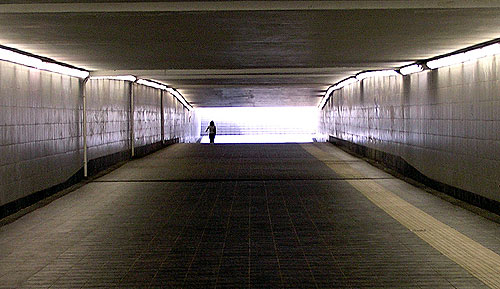

The hum of traffic merged into a polyglot of Latin, English, Spanish, and Polish prayers as pilgrims, who served as chorus throughout the play, entered with crosses, flowers, and pictures of the late pope, leaving their offerings at the foot of the sawhorses that now served as prayer rails. Graffiti etchings were revealed as prayers on behalf of loved ones in the hospital or at war in Afghanistan. A streak of headlights projected onto Bembridge's reconstruction of the underpass wall slowly dissolved into the glow of altar candles. As the house lights dimmed, a sense of ritualistic reverence and social relevance pervaded the space. Two yellow sawhorses barricaded the audience from the set, turning the spectators in this intimate house into a re-creation of a small crowd gathered at the site. Our Lady of the Underpass's restoration began with Brian Sidney Bembridge's scenic design of the image- what some claimed was the silhouette of the Virgin Mary left by a salt stain on a concrete underpass wall-before its obfuscation. gone voiceless." Similarly, as the only Equity Latino theatre company in the Midwest, Teatro Vista's production staked out cultural territory for ethnic theatre that is underrepresented within the city's larger arts community. Through the testimonies of the site's visitors, Saracho restored immigrant voices that she considered to have "politically and socially. For example, with the erection of the memorial, immigrant Catholic communities left their cultural mark on a cityscape that had increasingly ignored them through gentrification. Furthermore, the play served as a backdrop for the expression of more personal, political, and cultural absences marked by the shrine.


Based on interviews with visitors to the site, Saracho's "theatre of testimony" exemplified what performance scholar Jack Santino describes as a "performative commemorative." If, as Santino argues, roadside memorials mark a loss or death within a community, so too did Teatro Vista's production memorialize the underpass shrine, now eclipsed under palimpsestic layers of graffiti. Commuter Obdulia Delgado had no way of knowing that what she perceived as an image of the Virgin would create gridlock in public debate as religious pilgrims, predominantly from Latino and Polish immigrant communities, erected a roadside shrine that, quite literally, stopped traffic.Ī performance in and of itself, this original shrine and its followers were formally commemorated in Teatro Vista's staging of Tanya Saracho's Our Lady of the Underpass. After all, it was performed five years after an image of the Virgin Mary was recognized on a Chicago underpass following the loss of Pope John Paul II and the commission of Pope Benedict XVI. The radio news spoke of the Vatican sex scandal and I anticipated drawing some ironic connections between the trouble in Rome and the play. The commute into the city was hectic as usual. Piped into the house as part of the sound design and removed from the context of unwieldy traffic, the buzz of passing cars created an unexpected calming effect. The sound of the freeway stayed with me as I settled into the fifty-seat auditorium of the 16th Street Theater.


 0 kommentar(er)
0 kommentar(er)
